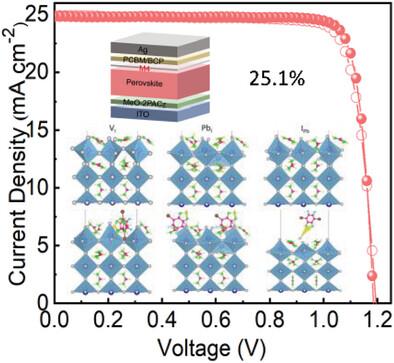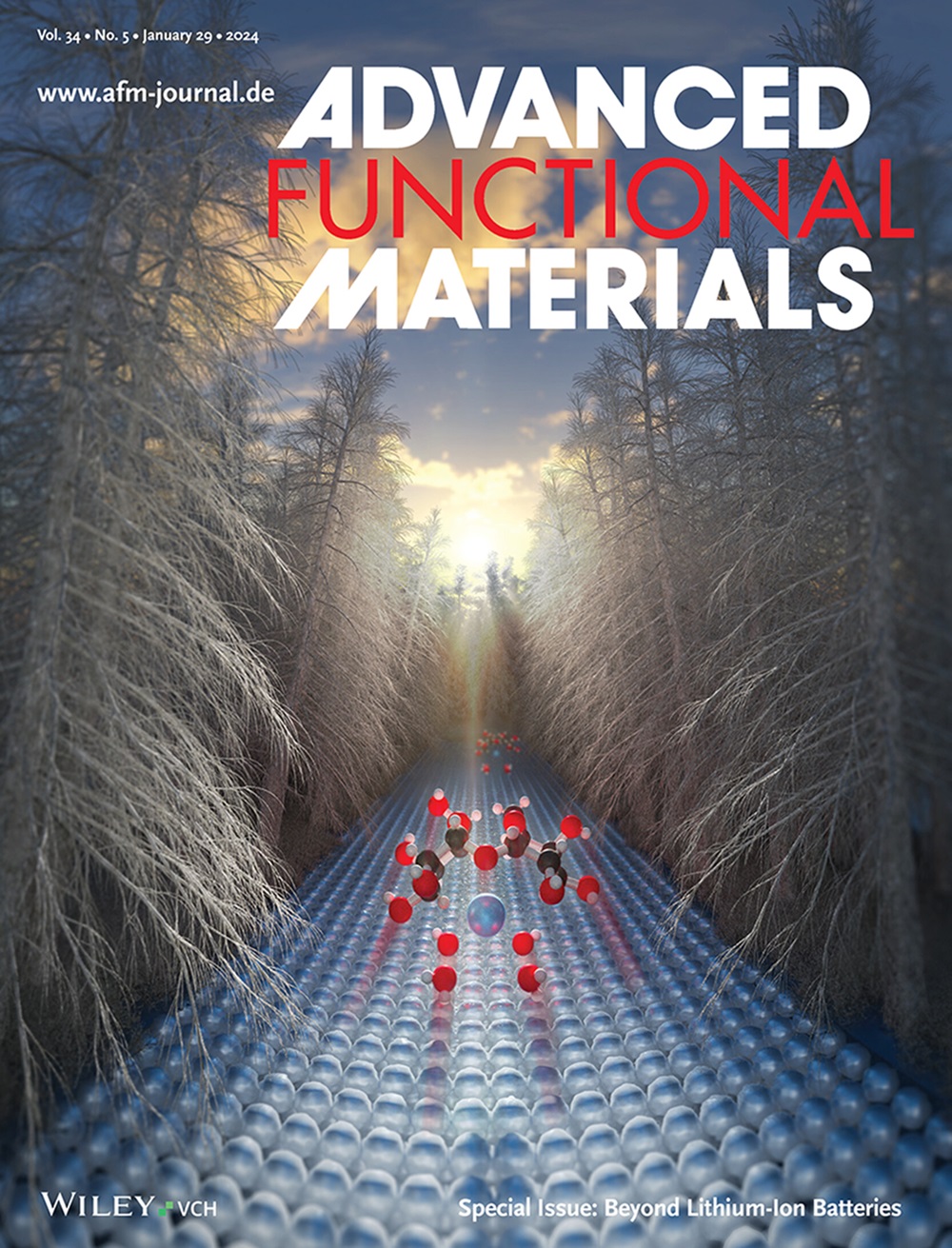Multi-Point Collaborative Passivation of Surface Defects for Efficient and Stable Perovskite Solar Cells
IF 18.5
1区 材料科学
Q1 CHEMISTRY, MULTIDISCIPLINARY
引用次数: 0
Abstract
The inherent defects (lead iodide inversion and iodine vacancy) in perovskites cause non-radiative recombination and there is also ion migration, decreasing the efficiency and stability of perovskite devices. Eliminating these inherent defects is critical for achieving high-efficiency perovskite solar cells. Herein, an organic molecule with multiple active sites (4,7-bromo-5,6-fluoro-2,1,3-phenylpropyl thiadiazole, M4) is introduced to modify the upper interface of perovskites. When M4 interacts with the perovskite surface, the active bromine (Br) site interacts with lead (Pb) at the surface to repair iodine atomic vacancy defects. The fluorine (F) site of M4 interacts with Pb to correct octahedral crystal lattice distortions and eliminate PbI defects. Additionally, sulfur–iodine (S–I) interactions reduce I–I dimerization and eliminate IPb defects. It is also calculated that the energy level of M4 aligns with the band gap, promoting charge transfer. As a result, the perovskite devices achieve an efficiency of 25.1%, a stabilized power output (SPO) of 25.0%, a voltage of 1.19 V, and a fill factor of 85.2%. The device retains 95% of its initial efficiency after 2000 h of ageing in a nitrogen atmosphere. Thus, multi-point cooperative passivation of surface defects provides an effective method to improve the efficiency and stability of perovskite solar cells.

多点协同钝化表面缺陷,实现高效稳定的 Perovskite 太阳能电池
包晶石中的固有缺陷(碘化铅反转和碘空位)会导致非辐射性重组,同时还会发生离子迁移,从而降低包晶石设备的效率和稳定性。消除这些固有缺陷对于实现高效率的过氧化物太阳能电池至关重要。本文引入了一种具有多个活性位点的有机分子(4,7-溴-5,6-氟-2,1,3-苯基丙基噻二唑,M4)来改变过氧化物晶石的上界面。当 M4 与包晶表面相互作用时,活性溴(Br)位点与表面的铅(Pb)相互作用,修复碘原子空位缺陷。M4 的氟(F)位点与铅(Pb)相互作用,修正八面体晶格畸变,消除 PbI 缺陷。此外,硫-碘(S-I)相互作用可减少 I-I 二聚化并消除 IPb 缺陷。计算还表明,M4 的能级与带隙一致,促进了电荷转移。因此,这种过氧化物器件的效率达到了 25.1%,稳定功率输出 (SPO) 为 25.0%,电压为 1.19 V,填充因子为 85.2%。该器件在氮气环境中老化 2000 小时后,仍能保持 95% 的初始效率。因此,表面缺陷的多点协同钝化为提高过氧化物太阳能电池的效率和稳定性提供了一种有效的方法。
本文章由计算机程序翻译,如有差异,请以英文原文为准。
求助全文
约1分钟内获得全文
求助全文
来源期刊

Advanced Functional Materials
工程技术-材料科学:综合
CiteScore
29.50
自引率
4.20%
发文量
2086
审稿时长
2.1 months
期刊介绍:
Firmly established as a top-tier materials science journal, Advanced Functional Materials reports breakthrough research in all aspects of materials science, including nanotechnology, chemistry, physics, and biology every week.
Advanced Functional Materials is known for its rapid and fair peer review, quality content, and high impact, making it the first choice of the international materials science community.
文献相关原料
| 公司名称 | 产品信息 | 采购帮参考价格 |
|---|
 求助内容:
求助内容: 应助结果提醒方式:
应助结果提醒方式:


